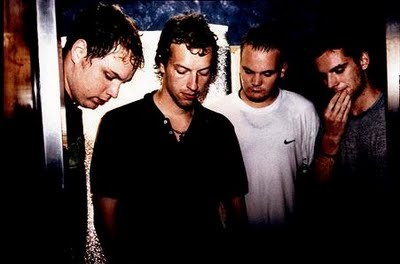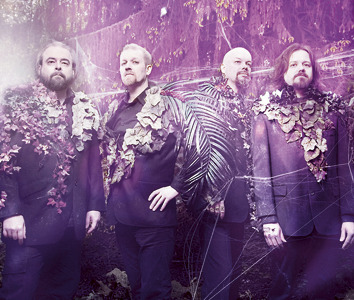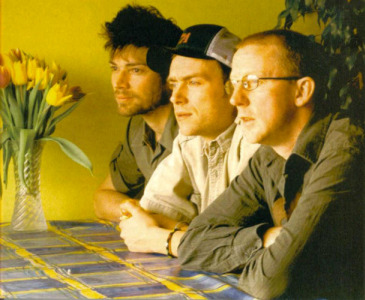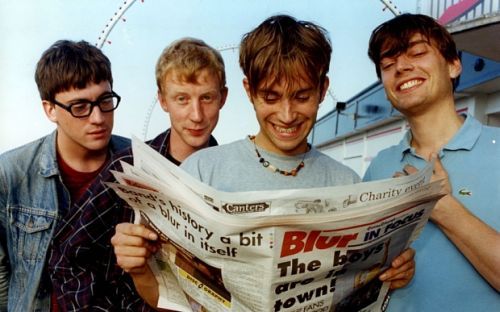
1) Life in Technicolour; 2) Cemeteries of London; 3) Lost!; 4) 42; 5) Lovers in Japan / Reign of Love; 6) Yes / Chinese Sleep Chant; 7) Viva La Vida; 8) Violet Hill; 9) Strawberry Swing; 10) Death and All His Friends / The Escapist
It's reinvention in the mainstream sense of things, but as a creative rejuvenation this is an incredibly successful one - and heck, we can probably credit this album for making its traits popular all over the place.
Key tracks: "Lovers in Japan", "Viva La Vida", "Death and All His Friends"
It's probably a bit hard to grasp the nature of what Viva la Vida or Death and All His Friends represents for Coldplay when, on a brief glance, all their history looks the same. Their albums before Viva La Vida were huge hits, Viva La Vida itself was a massive one and they continued on the same chart-topping trajectory after it. In the general gist of things Coldplay have always been one of the world's biggest bands, to the point that it's easy to equate everything they've done simply because it's always been successful. But even though it's never been very apparent in the grand scheme of things, Coldplay have always been a band who haven't been afraid to challenge themselves and change when things needed to be: the reason they've outlasted their peers is because they've been able to evolve. Viva La Vida is the epitome of all that. It is a re-invention that not only resurrected the band creatively, but changed them irreversibly.
When you look at the first three Coldplay albums, there's a clear trajectory of a band growing bigger in sound, audience and the space needed for that audience. The music itself across the three albums is all derived from the same starting point, just growing in scope and bombast. At the height of X&Y they were a massive stadium band, playing big pop/rock songs for big crowds – songs that you could have already found on the last two albums in a more downplayed form. The band had started to fall into a rut: the overall sound of X&Y is peppered with the feeling of making music they were being expected to make rather than what they were inspired to. At this stage you have two options: either accept this and continue releasing more of the same because that's what the fans and the people at large have proven they want from you, or refresh yourselves artistically and start from scratch. Coldplay opted for the latter.
If this sounds slightly over the top, pay attention to Viva La Vida's sound. While still consisting mostly of larger-than-life pop songs, Viva La Vida's sound world is from a completely different realm than the fairly straightforward rock band setup of the first three albums. There's all manners of layered percussion, a lot more emphasis is placed on atmospheric texture courtesy of Brian Eno and Jon Hopkins (with the former producing and the latter guest featuring), an electronic flair rears its head from time to time and off-the-cuff instruments like sitar and yanqqin make appearances in a way that sounds like the band just got into a studio containing every instrument ever created. There's a lot more experimentation within the songwriting too. Songs aren't afraid to take sudden twists in mood or tempo within themselves ("42" makes this the song's entire point), there's a lot more build-up intros and outros that the band normally would have chopped and occasionally you even hear whole new, unexpected elements like the sudden shoegaze blast of "Chinese Sleep Chant". The instrumental opener "Life in Technicolor" sounds like it could have been a big pop moment had it been fleshed out into a full song, and then you learn that it was intentionally stripped of its vocals in order to avoid taking that easy route. That's the kind of self-challenge the world's biggest band exhibits here (even though the band eventually went back on that and the song was returned to its original state in the Prospekt's March EP).
It could have fell flat on its face, a band reaching far beyond their limits in a desperate attempt to seem more credible, but it absolutely doesn't. Quite the opposite: this is where Coldplay's genuine qualities and talents are really revealed. It's not just about how rejuvenated they sound here after the slight by-the-numbers feels of X&Y and how that's been replaced by sheer inspiration and determination, but the real treat of Viva La Vida is how ear-pleasingly, foot-tappingly and sense-overwhelmingly golden it is in its actual music. This is what you get when you give a bunch of hitmakers the playground to roam freely and pair them with a producer who knows how to perfect any sound. All its layered sounds, bright vocal harmonies and gigantic melodies sound so unbelieveably joyous – full of sparkling life and bright passion. Everything sounds like it could be the best: the organ-driven battle march "Lost!", the life-affirming parade of melodies that makes up "Lovers in Japan", the suddenly rocked-up "Violet Hill", the utter bliss of "Strawberry Swing", the perfectly epic finale "Death and All His Friends" (which only flaw is how teasingly short its final climax is) and so many of the songs in-between each feel like the album has only just managed to hit its peak.
The Genuine Big Song, though, is quite obviously "Viva La Vida" itself, well on its way (or already having established itself as) to be Coldplay's signature song and clearly towering over everything else in its presence. The world fell in love with it and how could they not – the simple orchestral riff and steady kick drum beat give it a quick, direct route to anyone's head, the vague-enough lyrics lend it a sense of depth and the now-famous woo-oo-oohs hit crowd participation in the head. But to split it into some basic building blocks is doing it a disservice, and listening to it again without its constant presence everywhere really reveals how it absolutely deserves to be called a masterpiece: one where everything from production to performance and most importantly feeling come together to create a song that sounds quite like nothing else out there while still containing a sense of shared universal excellence to it. It also makes for an amazing point for the album itself: that the whole thing doesn't crumble or sound underwhelming after the centerpiece has left the stage only goes to show how well crafted the rest of the album is.
Listing everything else on the album would be easy, if a little excessive; god knows I have love for the bookends of "Life in Technicolor"/"The Escapist", the importance of the breather break "Reign of Love", how "Cemeteries of London" is such a wake-up moment straightaway regarding the band's new tides, etc. Here is a band at the top of their game, discovering their true selves and it's presented in the form of a musical journey. It also reveals a side of Coldplay that could have gone amiss before – a certain kind of defiant boldness. If the band's original success felt a bit like a coincidental by-product ("Yellow" is the lone extrovert among the rest of Parachutes' melancholy wallowing and A Rush of Blood to the Head only sounds like a part of a trend of its time because it started that trend off) and X&Y was the slightly-too-conscious attempt to match it, Viva La Vida is out to rewrite the rules; to tackle their success through their own means and with their own sound. For all the flak they get for sounding safe and how Viva La Vida's eventual success slightly obscured the point, Coldplay reached out for their adventurous side here and they came back with stunning results.

:format(jpeg):mode_rgb():quality(40)/discogs-images/R-3689118-1342269667-1665.jpeg.jpg)





:format(jpeg):mode_rgb():quality(90)/discogs-images/R-376817-1105548639.jpg.jpg)







:format(jpeg):mode_rgb():quality(40)/discogs-images/R-416946-1155176303.jpeg.jpg)




